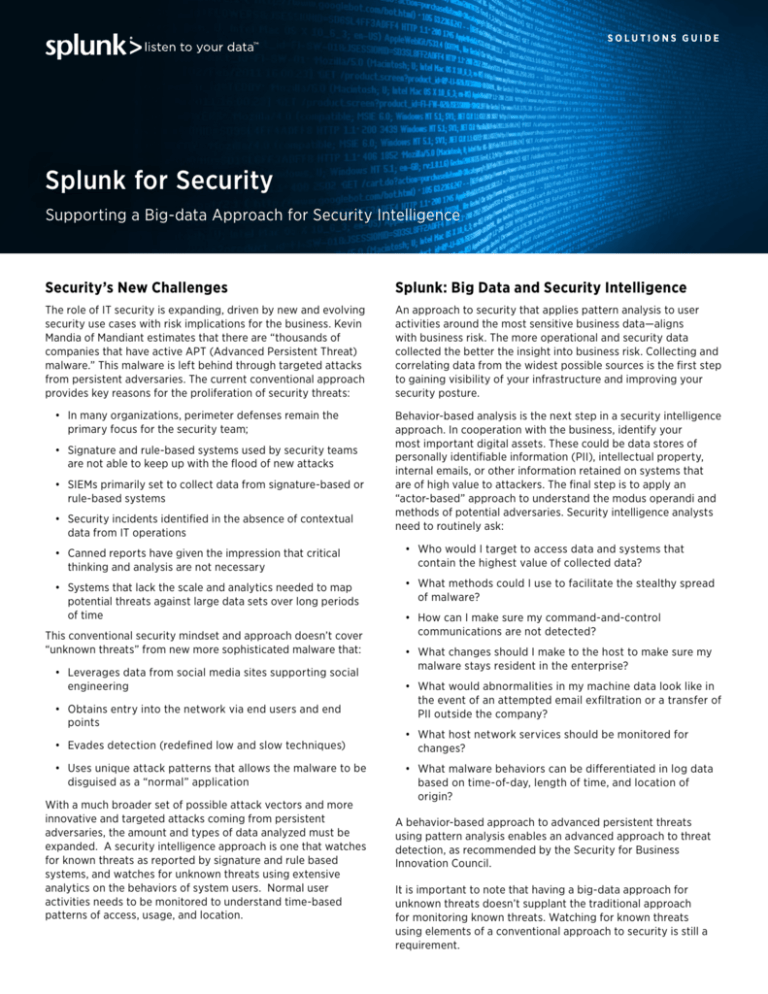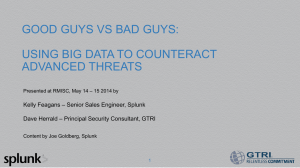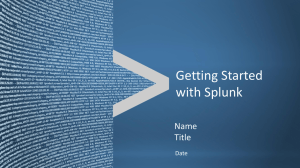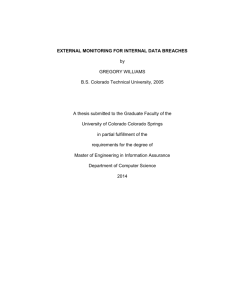
SOLUTIONS GUIDE
Splunk for Security
Supporting a Big-data Approach for Security Intelligence
Security’s New Challenges
Splunk: Big Data and Security Intelligence
The role of IT security is expanding, driven by new and evolving
security use cases with risk implications for the business. Kevin
Mandia of Mandiant estimates that there are “thousands of
companies that have active APT (Advanced Persistent Threat)
malware.” This malware is left behind through targeted attacks
from persistent adversaries. The current conventional approach
provides key reasons for the proliferation of security threats:
An approach to security that applies pattern analysis to user
activities around the most sensitive business data—aligns
with business risk. The more operational and security data
collected the better the insight into business risk. Collecting and
correlating data from the widest possible sources is the first step
to gaining visibility of your infrastructure and improving your
security posture.
đƫ In many organizations, perimeter defenses remain the
primary focus for the security team;
đƫ Signature and rule-based systems used by security teams
are not able to keep up with the flood of new attacks
đƫ SIEMs primarily set to collect data from signature-based or
rule-based systems
đƫ Security incidents identified in the absence of contextual
data from IT operations
Behavior-based analysis is the next step in a security intelligence
approach. In cooperation with the business, identify your
most important digital assets. These could be data stores of
personally identifiable information (PII), intellectual property,
internal emails, or other information retained on systems that
are of high value to attackers. The final step is to apply an
“actor-based” approach to understand the modus operandi and
methods of potential adversaries. Security intelligence analysts
need to routinely ask:
đƫ Canned reports have given the impression that critical
thinking and analysis are not necessary
đƫ Who would I target to access data and systems that
contain the highest value of collected data?
đƫ Systems that lack the scale and analytics needed to map
potential threats against large data sets over long periods
of time
đƫ What methods could I use to facilitate the stealthy spread
of malware?
This conventional security mindset and approach doesn’t cover
“unknown threats” from new more sophisticated malware that:
đƫ Leverages data from social media sites supporting social
engineering
đƫ Obtains entry into the network via end users and end
points
đƫ Evades detection (redefined low and slow techniques)
đƫ Uses unique attack patterns that allows the malware to be
disguised as a “normal” application
With a much broader set of possible attack vectors and more
innovative and targeted attacks coming from persistent
adversaries, the amount and types of data analyzed must be
expanded. A security intelligence approach is one that watches
for known threats as reported by signature and rule based
systems, and watches for unknown threats using extensive
analytics on the behaviors of system users. Normal user
activities needs to be monitored to understand time-based
patterns of access, usage, and location.
đƫ How can I make sure my command-and-control
communications are not detected?
đƫ What changes should I make to the host to make sure my
malware stays resident in the enterprise?
đƫ What would abnormalities in my machine data look like in
the event of an attempted email exfiltration or a transfer of
PII outside the company?
đƫ What host network services should be monitored for
changes?
đƫ What malware behaviors can be differentiated in log data
based on time-of-day, length of time, and location of
origin?
A behavior-based approach to advanced persistent threats
using pattern analysis enables an advanced approach to threat
detection, as recommended by the Security for Business
Innovation Council.
It is important to note that having a big-data approach for
unknown threats doesn’t supplant the traditional approach
for monitoring known threats. Watching for known threats
using elements of a conventional approach to security is still a
requirement.
SOLUTIONS GUIDE
Conventional
Approach
APT / Risk-Based Approach
Controls
Coverage
Protect all
information assets
Controls
Focus
Signature-based
preventive controls
(AV, Firewalls, IPS)
Detective controls - data analytics
Perspective
Perimeter-based
Data-centric
Goal of
Logging
Compliance
reporting
Threat Detection
Incident
Management
Find and neutralize
malware and/or
infected nodes
(reactive)
Big Picture: Seek, find and dissect
attack paterns (proactive)
Threat
Intelligence
Collect information
on malware
Develop deep understanding of
attackers modus operandi
in context of the organization’s key
assets and IT environment
No attackers get
into the network
Attackers sometimes get in, but
are detected quickly and impact
(risk) is minimized
Success
Definition
Focus efforts on most important
assets
Figure 2 - When Advanced Persistent Threats Go Mainstream, Security for
Business Innovation Council, 7/21/2011
“Rules-based SIEMs aren’t designed to detect
polymorphic attacks or patterns from advanced
persistent threats”
Splunk: The Platform for Security Intelligence
While the core Splunk Enterprise platform with its scalability,
analytics, visualization and alerting capabilities allow you to ask
scenario-based questions of your data, Splunk is also a platform
for security apps (over thirty as of this writing). These are
available on Splunkbase.com.
The Splunk App for Enterprise Security
The Splunk app for Enterprise Security supports SIEM
capabilities and watches for known threats and monitors key
security metrics. This app operates as a ‘lens’ into your security
data. It is designed for the security professional organizing
data into specific security domains while collecting data from
traditional security architectures automatically, and delivers
real-time dashboard visualizations. The App can act as a
jumping off point into unknown threat detection, support
identity correlation or manage a team of security experts who
review incidents on a daily bases. The Splunk App for Enterprise
Security is an important part of a security intelligence strategy.
This timeline can be used to focus on the precise moment in time
a security event occurred. Any search result can be turned into a
report for distribution. This is especially useful for ad-hoc queries
in support of compliance initiatives such as PCI, SOX or HIPAA.
Real-time Forensics Operationalized
Once a forensic investigation is complete, Splunk searches can
be saved and monitored in real time. Real-time alerts can be
routed to the appropriate security team members for followup. Correlation across system data by vendor or data type is
supported in Splunk’s easy-to-use search language.
Splunk’s search language supports correlations that can
generate alerts based on a combination of specific conditions,
patterns in system data or when a specific threshold is reached.
“Splunk allows us to quickly consolidate and
correlate disparate log sources, enabling previously
impractical monitoring and response scenarios.”
Splunk lets you see real-time information from security and
network devices, operating systems, databases and applications,
on one timeline enabling security teams to quickly detect and
understand the end-to-end implications of a security event.
Splunk watches for hard-to-detect patterns of malicious activity
in machine data that traditional security systems may not
register. This approach can also provide the building blocks for a
variety of supported fraud and theft detection use cases.
“Our Security and Fraud teams detect and
investigate fraudulent activity quickly.”
Metrics and Operational Visibility
Understanding business risk requires a metrics-based approach
to measure effectiveness over time. Splunk’s built-in search
language contains the commands needed to express search
results as tables, graphics, and timelines on security dashboards.
Key performance indicators (KPIs) can be monitored by business
unit, compliance type, location and more.
Real-time Correlation and Alerting
Correlation of information from different data sets can reduce
false-positives and provide additional insight and context. For
long-term correlations, Splunk can write individual system events
to internal files also monitored by Splunk and aged out over time.
If the right group of events writes to the file, before it is aged
out, the correlation is completed and an alert is issued. Splunk
supports a rich set of alert creation criteria providing rule based
alert suppression and thresholds.
Free Download
Using Splunk for Security
Flexible, Scalable Security Investigation
Splunk is scalable and flexible enough to search across
terabytes of data from any data source such as traditional
security sources, custom applications, and databases. Splunk
automatically provides a time-line view of all collected data.
250 Brannan St, San Francisco, CA, 94107
Download Splunk for free. You’ll get a Splunk Enterprise license
for 60 days and you can index up to 500 megabytes of data per
day. You can convert to a perpetual Free license or purchase an
Enterprise license by contacting sales@splunk.com.
info@splunk.com | sales@splunk.com
866-438-7758 | 415-848-8400
www.splunkbase.com
www.splunk.com
Copyright © 2012 Splunk Inc. All rights reserved. Splunk Enterprise is protected by U.S. and international copyright and intellectual property laws.
Splunk is a registered trademark or trademark of Splunk Inc. in the United States and/or other jurisdictions. All other marks and names mentioned
herein may be trademarks of their respective companies. Item # SG-Splunk-Security-106








